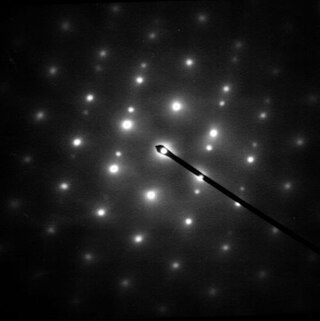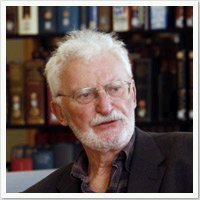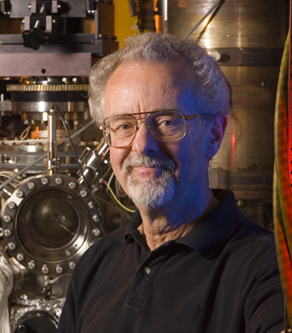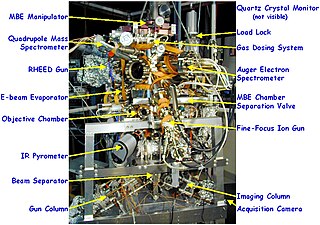Related Research Articles

Electron diffraction is a generic term for phenomena associated with changes in the direction of electron beams due to elastic interactions with atoms. It occurs due to elastic scattering, when there is no change in the energy of the electrons. The negatively charged electrons are scattered due to Coulomb forces when they interact with both the positively charged atomic core and the negatively charged electrons around the atoms. The resulting map of the directions of the electrons far from the sample is called a diffraction pattern, see for instance Figure 1. Beyond patterns showing the directions of electrons, electron diffraction also plays a major role in the contrast of images in electron microscopes.
Clinton Joseph Davisson was an American physicist who won the 1937 Nobel Prize in Physics for his discovery of electron diffraction in the famous Davisson–Germer experiment. Davisson shared the Nobel Prize with George Paget Thomson, who independently discovered electron diffraction at about the same time as Davisson.

The Davisson–Germer experiment was a 1923–1927 experiment by Clinton Davisson and Lester Germer at Western Electric, in which electrons, scattered by the surface of a crystal of nickel metal, displayed a diffraction pattern. This confirmed the hypothesis, advanced by Louis de Broglie in 1924, of wave-particle duality, and also the wave mechanics approach of the Schrödinger equation. It was an experimental milestone in the creation of quantum mechanics.

Heinrich Rohrer was a Swiss physicist who shared half of the 1986 Nobel Prize in Physics with Gerd Binnig for the design of the scanning tunneling microscope (STM). The other half of the Prize was awarded to Ernst Ruska. The Heinrich Rohrer Medal is presented triennially by the Surface Science Society of Japan with IBM Research – Zurich, Swiss Embassy in Japan, and Ms. Rohrer in his memory. The medal is not to be confused with the Heinrich Rohrer Award presented at the Nano Seoul 2020 conference.
Joachim Stöhr is a physicist and professor emeritus of the Photon Science Department of Stanford University. His research has focused on the development of X-ray and synchrotron radiation techniques and their applications in different scientific fields with emphasis on surface science and magnetism. During his career he also held several scientific leadership positions, such as the director of the Stanford Synchrotron Radiation Laboratory (SSRL) and he was the founding director of the Linac Coherent Light Source (LCLS), the world's first x-ray free electron laser.

Earl Ward Plummer was an American physicist. His main contributions were in surface physics of metals. Plummer was a professor of physics at Louisiana State University, University of Pennsylvania and the University of Tennessee - Knoxville.
The Davisson–Germer Prize in Atomic or Surface Physics is an annual prize that has been awarded by the American Physical Society since 1965. The recipient is chosen for "outstanding work in atomic physics or surface physics". The prize is named after Clinton Davisson and Lester Germer, who first measured electron diffraction, and as of 2007 it is valued at $5,000.

Low-energy electron microscopy, or LEEM, is an analytical surface science technique used to image atomically clean surfaces, atom-surface interactions, and thin (crystalline) films. In LEEM, high-energy electrons are emitted from an electron gun, focused using a set of condenser optics, and sent through a magnetic beam deflector. The “fast” electrons travel through an objective lens and begin decelerating to low energies near the sample surface because the sample is held at a potential near that of the gun. The low-energy electrons are now termed “surface-sensitive” and the near-surface sampling depth can be varied by tuning the energy of the incident electrons. The low-energy elastically backscattered electrons travel back through the objective lens, reaccelerate to the gun voltage, and pass through the beam separator again. However, now the electrons travel away from the condenser optics and into the projector lenses. Imaging of the back focal plane of the objective lens into the object plane of the projector lens produces a diffraction pattern at the imaging plane and recorded in a number of different ways. The intensity distribution of the diffraction pattern will depend on the periodicity at the sample surface and is a direct result of the wave nature of the electrons. One can produce individual images of the diffraction pattern spot intensities by turning off the intermediate lens and inserting a contrast aperture in the back focal plane of the objective lens, thus allowing for real-time observations of dynamic processes at surfaces. Such phenomena include : tomography, phase transitions, adsorption, reaction, segregation, thin film growth, etching, strain relief, sublimation, and magnetic microstructure. These investigations are only possible because of the accessibility of the sample; allowing for a wide variety of in situ studies over a wide temperature range. LEEM was invented by Ernst Bauer in 1962; however, not fully developed until 1985.
Robert Gomer was an Austrian scientist known for his research on field electron emission and field ionization, and his role as an adviser to the United States government.

Ernst G. Bauer is a German-American physicist known for his studies in the field of surface science, thin film growth and nucleation mechanisms and the invention in 1962 of the Low Energy Electron Microscopy (LEEM). In the early 1990s, he extended the LEEM technique in two directions by developing Spin-Polarized Low Energy Electron Microscopy (SPLEEM) and Spectroscopic Photo Emission and Low Energy Electron Microscopy (SPELEEM). He is currently Distinguished Research Professor Emeritus at the Arizona State University.
Jerry Tersoff is a Research Staff Member at the IBM Thomas J. Watson Research Center. His work spans diverse topics in the theoretical understanding of surfaces, interfaces, electronic materials, epitaxial growth, and nanoscale devices. Throughout his career, his work has emphasized the use of simple models to understand complex behavior.

Walter Alexander "Walt" de Heer is a Dutch physicist and nanoscience researcher known for discoveries in the electronic shell structure of metal clusters, magnetism in transition metal clusters, field emission and ballistic conduction in carbon nanotubes, and graphene-based electronics.

Michael F. Crommie is an American physicist, a professor of physics at the University of California, Berkeley. World-renowned for his research on condensed-matter physics, he is a recipient of both the Newcomb-Cleveland Prize and the Davisson–Germer Prize in Atomic Physics. Crommie currently directs the Crommie Research Group.
Homer Dupre Hagstrum was an American physicist who specialized in surface physics.
Nora Berrah is an Algerian physicist who studies how light and matter interact. She is a professor at the University of Connecticut, where she previously was chair of the physics department.
Epitaxial graphene growth on silicon carbide (SiC) by thermal decomposition is a method to produce large-scale few-layer graphene (FLG). Graphene is one of the most promising nanomaterials for the future because of its various characteristics, like strong stiffness and high electric and thermal conductivity. Still, reproducible production of Graphene is difficult, thus many different techniques have been developed. The main advantage of epitaxial graphene growth on silicon carbide over other techniques is to obtain graphene layers directly on a semiconducting or semi-insulating substrate which is commercially available.

Patricia Ann Thiel was an American chemist and materials scientist who served as a distinguished professor of chemistry at Iowa State University. She was known for her research on atomic-scale structures and processes on solid surfaces.
Randall M. Feenstra is a Canadian physicist. He completed a bachelor's degree in engineering physics at the University of British Columbia in 1978, followed by his master's and doctorate in applied physics at the California Institute of Technology. From 1982 to 1995 he was a research staff member at the IBM Thomas J. Watson Research Center in Yorktown Heights, New York. Since 1995, he has taught at Carnegie Mellon University, where he conducts research in semiconductors.

Theodore E. Madey was an American condensed matter physicist who specialized in the chemistry and physics of surfaces. He was a professor in the physics and chemistry departments at Rutgers University at the time of his death.
Shirley Chiang is an American microscopist focused on the high-resolution imaging of surfaces, including the use of scanning tunneling microscopy and low-energy electron microscopy, and known for capturing the first image showing the ring structure of benzene molecules. She is a professor at the University of California, Davis, in the Department of Physics and Astronomy, and editor-in-chief of the MDPI journal Nanomaterials.
References
- 1 2 "2003 Davisson-Germer Prize in Atomic or Surface Physics Recipient". American Physical Society . Retrieved 12 December 2019.
- ↑ "Ruud Tromp | Professor of Physics of surfaces and materials". Leiden University . Retrieved 12 December 2019.
- ↑ Tromp, R. M.; Hannon, J. B.; et al. (June 2010). "A new aberration-corrected, energy-filtered LEEM/PEEM instrument. I. Principles and design". Ultramicroscopy . 110 (7): 852–861. doi:10.1016/j.ultramic.2010.03.005. PMID 20395048.
- ↑ "Past Winners of the Nottingham Prize". Princeton University . Retrieved 12 December 2019.
- ↑ "MRS Medal Recipients". Materials Research Society . Retrieved 12 December 2019.
- ↑ "Medard W. Welch Award". American Vacuum Society . Archived from the original on 3 April 2005. Retrieved 12 December 2019.
- ↑ "List of MRS Fellows". Materials Research Society. Retrieved 12 December 2019.
- ↑ "Medard W. Welch Award". American Vacuum Society. Retrieved 12 December 2019.
- ↑ "Rudolf Tromp to receive the Davisson-Germer Prize | Recognized for his understanding of semiconductor surfaces and interfaces" (Press release). 3 March 2003. Archived from the original on March 4, 2016. Retrieved 12 December 2019.
- ↑ "Society Honors". American Vacuum Society. Retrieved 12 December 2019.
- ↑ "Morning Keynote Speaker - Dr. Rudolf Tromp" (PDF). Brookhaven National Laboratory . Retrieved 12 December 2019.
- ↑ R. Colin Johnson (17 March 2003). "Growth envisioned for semiconducting crystals". EE Times . Retrieved 12 December 2019.